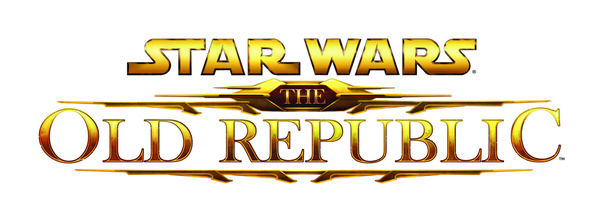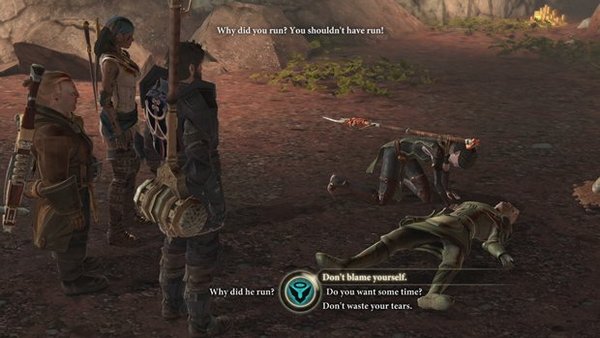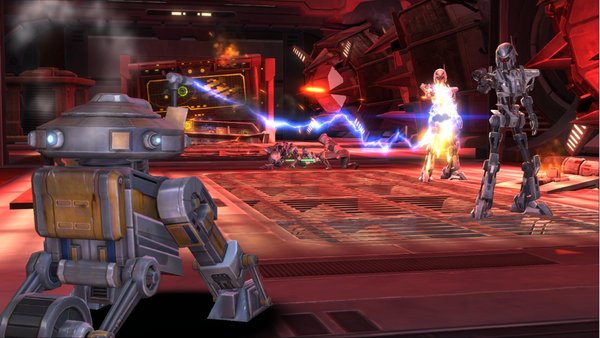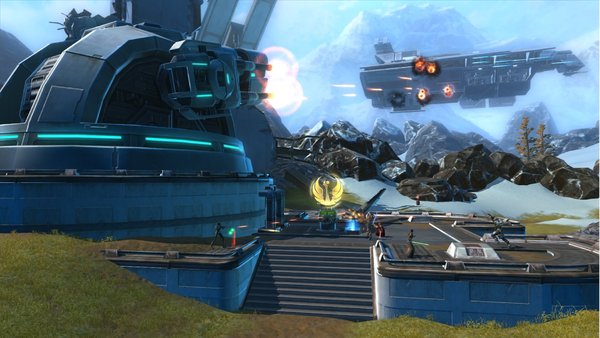Star Wars: The Old Republic is an interesting beast. Developed by a company better known for its ability to tell compelling interactive stories rather than couple those tales with top tier gameplay, I feel it may end up with something of an identity crisis.
While the attempt to add something resembling a decent story into the routinized trenches of the MMO space is a noble goal, one has to question what the appeal of an MMO is in the first place. Grounding a gigantic interactive universe in compelling fiction is well and good, but that effort is meaningless if the players don’t care. I’m willing to bet this is the mentality of the average MMO player.
That’s not meant to be a dig. It’s simply a matter of the strengths and weaknesses of the genre. Broadly speaking, there are two ways to tell a story in a video game. The first is the method increasingly popular in modern games – the linear tunnel that carefully guides the player down a strict path chosen specifically to provide the most interactive oomph. It may remove some of the player’s freedom, but when done right this method pairs a time-honored, traditional method of linear storytelling with interactive gameplay that makes the player feel a part of the proceedings. Bioware’s past offerings have largely fallen into this category. They skew toward the freedom side of the equation, relatively speaking, offering story and character customization choices that make their games feel highly personal, but they are still strictly guided progressions.
The other storytelling method is letting the player make his own story through emergent gameplay. In short, this means giving the player a large world to roam in and a bunch of tools to play with and letting him craft his own story. Open world games used to be a haven for this sort of thing. Grand Theft Auto, for instance, never managed to provide missions that were nearly as compelling as simply screwing around in its world and later telling your friends the story of how an innocent meeting with a lady of the evening in an alley turned into a mad dash for your life as you were pursued by a small army of cops and helicopters only to go out in a blaze of glory as you leapt off of the nearest convenient building firing rockets madly into the chaos on the streets below.
In an interesting twist, it has become popular of late to attempt to awkwardly merge these two storytelling forms. Grand Theft Auto IV downplayed the open world chaos in favor of a stronger focus on its serious storytelling but maintained the almost vestigial open world. L.A. Noire provided a gorgeous recreation of 1940s Los Angeles to explore but was so caught up in its fancy facial animation and plot progression that it forgot to actually do anything with it.
Even World of Warcraft isn’t immune. What was once a giant fantasy sandbox run by its players is slowly becoming a carefully managed pseudo-tunnel full of cutscenes and instanced missions. Blizzard is obviously struggling to figure out a way to get players to pay attention to its story and stop skipping the forgettable quest text.
Here’s the dirty secret: it will never work.
These two storytelling methods are polar opposites. As much as developers may try, you can’t guide a player down a narrow path and still call it a true open world. You can’t tack some story onto a sandbox and call it a thrilling narrative. These methods of story construction are best when they remain pure and focused, not try to do everything at once.
What Bioware is attempting to do is make an MMO that innovates in an area that’s not particularly important for MMOs. I fear the company may be ignorant as to the reason there’s no MMO out there that does story well. It’s not because it’s impossible or that no one has tried – although certainly no one has put nearly as much money into doing so as EA and Bioware. No, the reason is that strong storytelling simply doesn’t mix with an MMO. It can’t on a fundamental level and most players probably wouldn’t want it even if it did.
MMOs are fun because of the social element – the emergent gameplay that forms as a result of questing with friends, showing off your loot, and generally sharing the experience with others in one way or another. Blizzard has handled World of Warcraft’s storytelling efforts with a light touch so they don’t tend to get in the way. Additionally, they often provide for memorable gameplay moments (something which The Old Republic lacks, but we’ll get to that in a moment). Bioware has committed wholeheartedly to story, filling every quest with voice acting and context. While this is a terrific novelty at first, I fear it may be a doomed path.
Even in my first weekend with the game, it was already a struggle to suspend my disbelief as the game attempted to convince me I was the One True Hero despite the hundreds of other One True Heroes doing exactly the same quests at the same time as I was. The story, interesting though it may at times be, doesn’t even attempt to account for its MMO setting and the result is often seriously awkward at best. Perhaps these moments could have been lessened with a story written with a different focus – telling your character’s small role in a large event, for instance - as opposed to treating you as the sole hero.
No amount of storytelling prowess is going to account for The Old Republic’s primary misstep, however. Bioware’s strong suit has never been polished gameplay. In their narrative-driven single player games this is largely excusable. I’m invested enough in my tale of Commander Shepard’s epic adventure that I can forgive the occasional clunkiness. The Old Republic is saddled with a story ill-fitting for its genre. With a keen eye for gameplay innovation this could have made for a fine pairing – an interesting new take on MMO gameplay coupled with a story that, while imperfect, is better than anything else on the market.
Instead what we get is World of Warcraft in space. I don’t mean to imply it’s a wholesale copy – there are plenty of differing features on the periphery – but the core of the experience stems thoroughly from the mold that Blizzard cast seven years ago with the release of their mammoth genre-defining title.
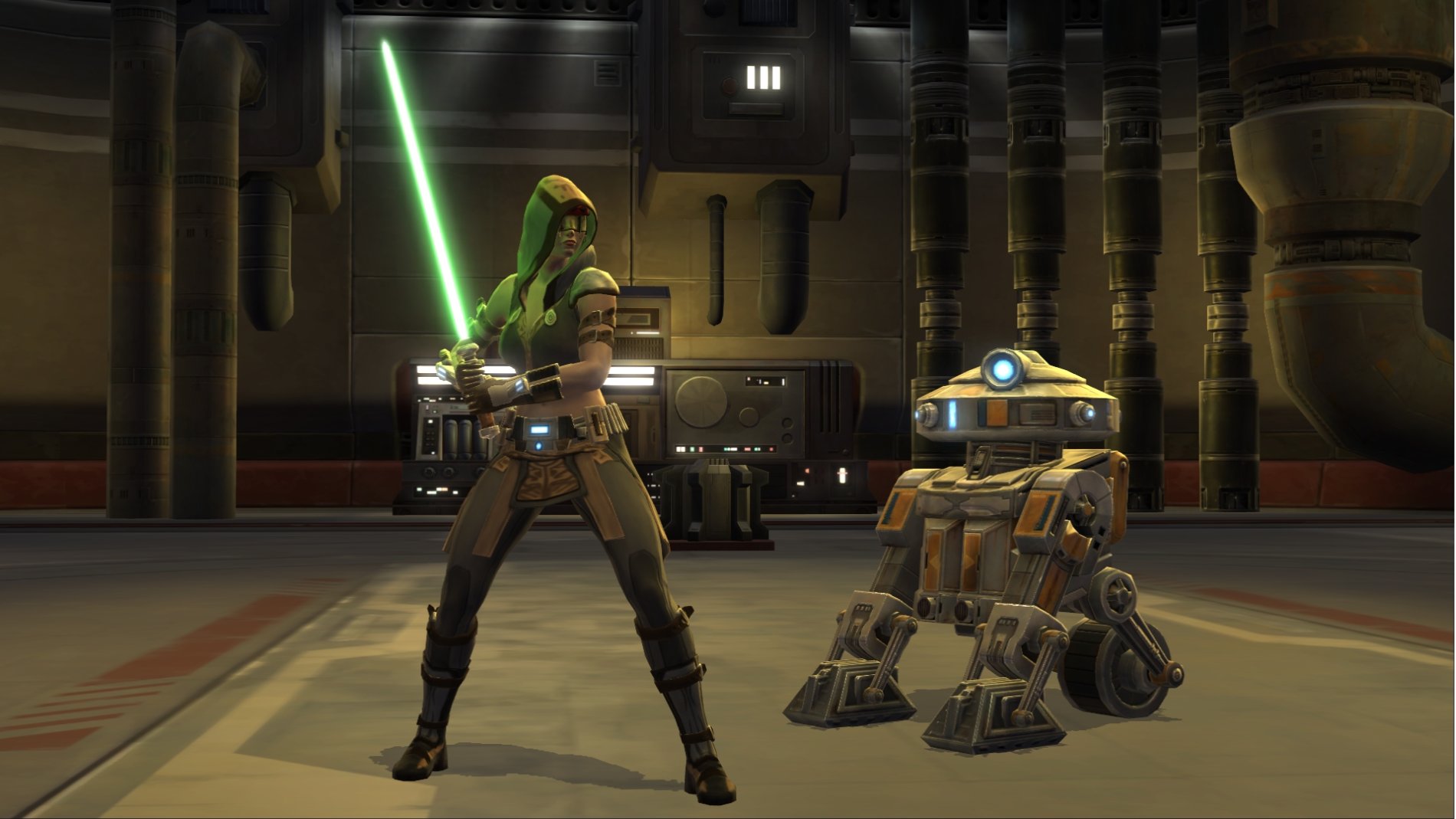
Not only that, but The Old Republic has to contend with Blizzard’s seven years of adding, tweaking, and polishing. WoW’s Cataclysm expansion eliminated a great deal of the tedium from the notoriously rote quest lines that plagued those unfortunate soles not playing one of the recent expansion packs. The mini-games, amusing story arcs, and gameplay twists did wonders to make the game entertaining again.
Clearly Bioware thought it best to pair their story with familiar gameplay so as not to scare away the millions they need to make their money-pit of a game financially successful, but they seem not to have learned from lessons Blizzard has taught us over the years. The Old Republic is old-school WoW in the worst way. It’s hard to ignore that your tale of epic heroism comes in short bursts between hours of quests that almost entirely consist of “Go here. Kill that.” If you’re truly lucky, you might come across a “Go here. Find that.” quest instead to really shake things up.
An abundance of boring quests are paired with a combat system that truly is a blatant copy of World of Warcraft – a gameplay style that many players have had plenty of time to get sick of over the last seven years. The toolbar-fueled repetition of this hands-off combat is snooze-inducing. The fancy force powers and glowy lightsabers provide only a brief novelty before you realize you’ve done this all before.
So what we end up with is something of a mess. Bioware has displayed its typical preference for ignoring mechanical innovation in favor of unique story ideas, only this time it has done so in a genre decidedly ill-suited to such fancies. The story that strings it all together certainly tops anything I’ve come across in the MMO scene, but I never shook the feeling that they should have made Knights of the Old Republic 3 instead. It’s a single player story in a multiplayer setting built on top of entirely forgettable mechanics.
I truly enjoyed my time with the game at first, but my enjoyment came entirely from playing it as a single player game. A weekend would not have been enough for the weight of these truths to sink in of their own accord were it not for the opinions of others I read elsewhere that nudged my mind in the proper direction. The consequences of Bioware’s design decisions may not show through for a few months after launch. The overly familiar mechanics will wear out their welcome. There will be an exodus of disillusioned souls who were expecting something different to begin with, only to meet with a nasty, WoW-flavored surprise. The story will cease to be compelling motivation for killing 30 more faceless goons when what you really want to do is go back and play Knights of the Old Republic again.
All that said, there is potential in The Old Republic. I shall not be cancelling my preorder and should the game survive into its second, third, or fourth year, I eagerly await the game it might become. At the very least it cannot be denied that it is a fun way to inhabit a huge chunk of the beloved Star Wars universe. It might well survive on this merit alone. No game with a size and scope as large as what an MMO promises will launch smoothly. World of Warcraft has come an astoundingly long way in seven years. Perhaps there are some basic mechanical decisions that cannot be undone, but Bioware’s attempt at a massively multiplayer Star Wars story could still be saved. The question is: will the populace be patient enough to wait for them to save it?
